ISSN ONLINE(2278-8875) PRINT (2320-3765)
ISSN ONLINE(2278-8875) PRINT (2320-3765)
Haroon Ashfaq1, Surendra Kumar Tripathi2
|
| Related article at Pubmed, Scholar Google |
Visit for more related articles at International Journal of Advanced Research in Electrical, Electronics and Instrumentation Engineering
This paper deals with permanent magnet synchronous generator (PMSG) based wind energy conversion system (WECS) integrated with grid with two back to back connected converters with a common DC link. The aim of this research is to model control of direct driven 1.5 MW wind turbine permanent magnetic synchronous generator (PMSG) which feeds alternating current (AC) power to the utility grid .The machine side converter is used to extract maximum power from the wind. In this paper a study of WECS is done by using a constant speed direct-driven wind turbine in Matlab. Moreover, by maintaining the dc link voltage at its reference value, the output ac voltage of the inverter can be kept constant irrespective of variations in the wind speed and load. An effective control techniques to extract maximum power from wind turbine is maximum power point tracking controller (MPPT), grid side controller also called voltage controller, pitch controller, phase lock loop controller (PLL) also used in this project, transformer used for isolation purpose, crow bar circuit used for protection the whole system.
Keywords |
| Wind Energy Conversion System (WECS), Double feed induction generator (DFIG), Matrix converter (MC), Back to back converter, Maximum power point tracking (MPPT), Wind turbines(WT), Wind generators(WG). |
INTRODUCTION |
| With the development of wind power generation the green energy trend is being projected and flourished globally. Increased amount of electricity produced from WECS is one of the ways to reach the goal of lowering emissions of greenhouse gases from energy production. Installed wind turbines and wind power plants have increased both in size and number in recent years significantly. However, research is still required to ensure the reliability of grid connected wind energy conversion system. Many techniques have been proposed in various research work which discuss the smooth mechanical to quality electrical energy conversion can be realized, have been proposed and developed with commercial success [1]-[2]. |
| Global market forecast regarding wind power development gives the encouraging sign. Growth forecast advocates the significant contribution of WECS for global net power demand. The effect of wind power generation on system stability has gained more importance with increasing penetration of wind power generation in power system. Wind power generation can affect the power system stability in two ways: First it is because of the uncertainty of wind energy nature. The next issue is grid connected wind energy conversion system instability due to a disturbance on power grids of in the WECS side that leads to complete power system instability. As far as power system stability is concern the basic parameters include rotor angle stability, frequency stability and voltage stability as shown in Fig.1 [3]-[5]. |
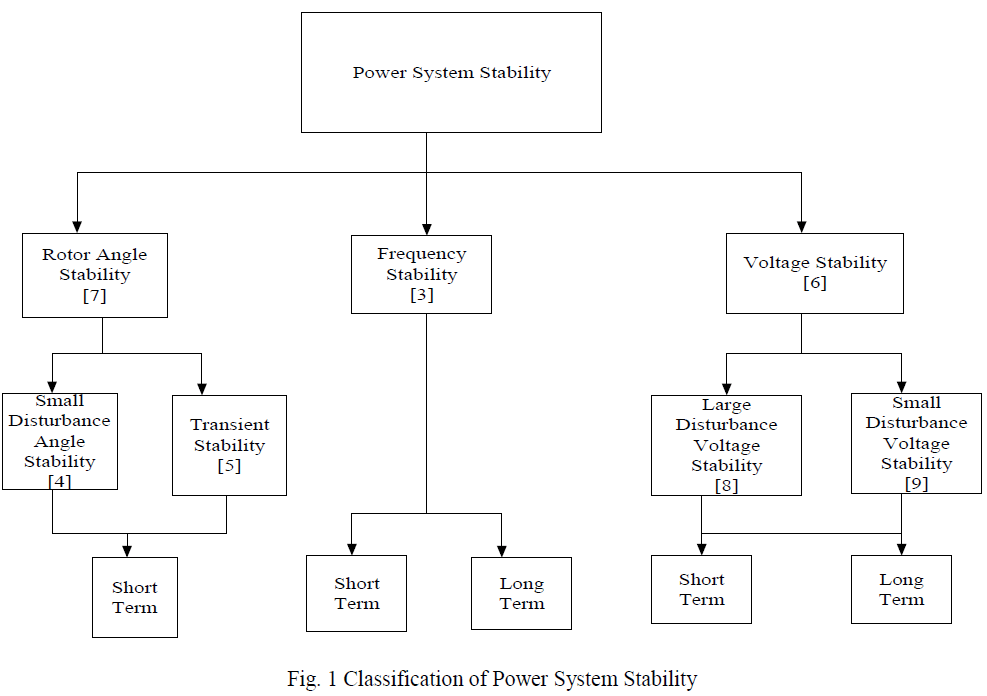 |
| The rotor angle stability governs the small disturbance angle stability and the transient stability. This is important to ensure the quality power during wind gusts. This has short term effect. Another important parameter is the frequency stability which is having short term as well as long term effect depending on the wind quality. Voltage stability is the compliment of small disturbance voltage stability and large disturbance voltage stability [6], [7]. This also has the short term and long term stability issues. The detailed comparison is shown in the above Fig. 1. |
| In case of renewable power generation the wind energy has been identified as the most swiftly growing technology with the development up to the megawatts capacity of wind turbines with the large power generators and power electronic converters.. Recently, voltage source converter (VSC) based doubly fed induction generator (DFIG) is considered to be highly reliable and efficient. To harness maximum amount of wind energy under varying wind velocity conditions, Doubly Fed Induction Generator (DFIG) seems to be one of the promising options, although various other generators such as Squirrel Cage Induction Generators (SCIG) and Permanent Magnet Synchronous Generators (PMSG) are also emerging as tough competitors to DFIG. Based on electrical topology, wind turbine generators are broadly grouped in to four categories namely (i) Fixed speed SCIG (ii) Variable slip (wound rotor) induction generator with variable rotor resistance (iii) Variable speed DFIG with partially rated converter interface (iv) Variable speed generators (either SCIG or PMSG) with full converter interface [8],[9]. |
| It is very important to assure that the grid is capable of staying within the operational limits of voltage and frequency for all expected combination of WECS and consumer load and at the same time maintaining transient stability of connected grid. |
POWER CHARACTERISTICS OF WIND TURBINE |
| Wind turbine is a non-linear system whose output depends on various parameters such as wind velocity, dimensions of the wind turbine and tip speed ratio. The power extracted (Pwt) by a wind turbine is |
 |
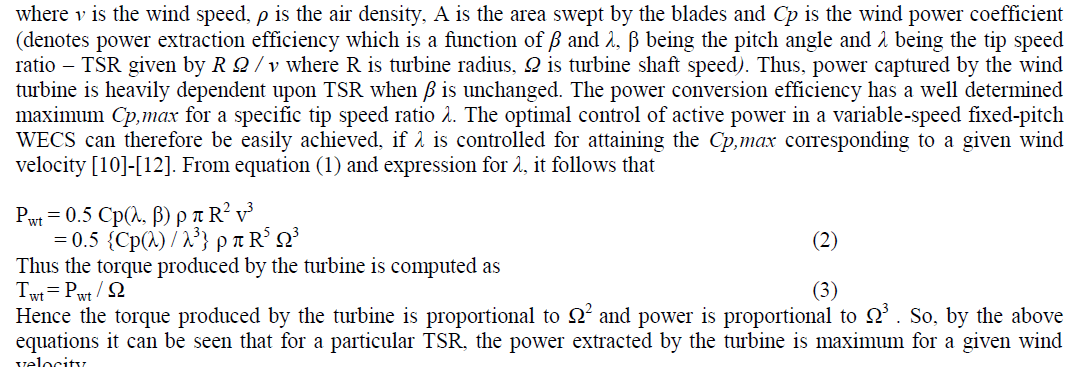 |
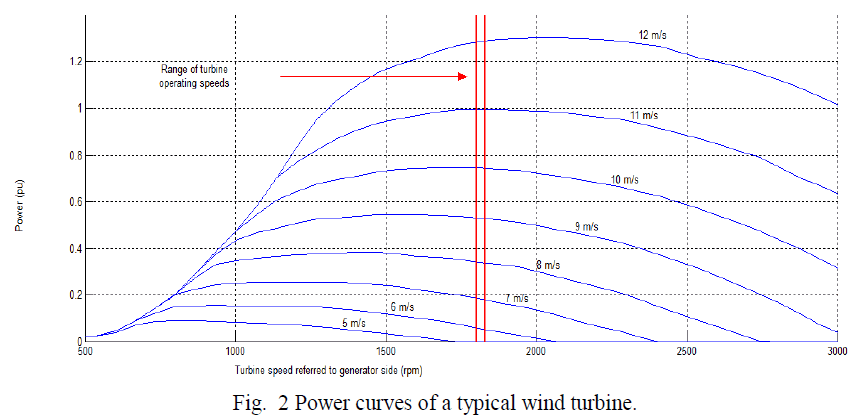 |
| This is equivalent to maintaining the tip speed ratio at its optimal value λopt and can be achieved by operating the turbine at a variable speed, corresponding to the wind speed. Fig. 2 represents the power curves of a typical wind turbine of wind energy conversion system (WECS). |
WIND GENERATORS |
| On the basis of rotation speed, wind turbines can be classified into fixed speed, limited variable speed and variable speed type. The variable speed wind turbines are classified into various WECS generator systems with a partial scale and a full-scale power electronic converter based on the rating of power electronic converter related to the generator capacity. In addition, considering the drive train components, the wind turbine concepts can be classified into geared drive and direct-drive wind turbines. In geared-drive wind turbines, one conventional configuration is a multiple-stage gear with a high-speed generator; the other one is the multibrid concept which has a single stage gear and a low-speed generator. In this section, according to contemporary wind turbine concepts, the basic configurations and characteristics of different wind generator systems are described. Almost all wind turbines installed up to now use either one of the following systems: (a) fixed speed induction generator (squirrel cage induction generator); (b) doubly fed induction generator; (c) direct drive synchronous generator [13]-[15]. |
A. FIXED SPEED INDUCTION GENERATORS (FSIG) |
| The fixed speed induction generator (FSIG) is consisting of squirrel cage induction generator that is coupled through a gearbox to the wind turbine rotor as shown in Fig. 3. This type of wind turbine is simple and cheap. The well -known advantages of FSIG are it is robust, easy and relatively cheap for mass production. In addition, it enables stall-regulated machines to operate at a constant speed when it is connected to a large grid, which provides a stable control frequency. Although the stall control method is usually used in combination with the fixed speed FSIG for power control, the active stall control or pitch control have also been applied. |
| But it has reported various disadvantages like lack of control possibilities of both active and reactive power, gearbox breakdown due to large mechanical loads (because of power fluctuations are converted to torque pulsations) and the large fluctuations in output power. Due to these reasons, wind turbine manufacturers are increasingly interested in variable speed devices. |
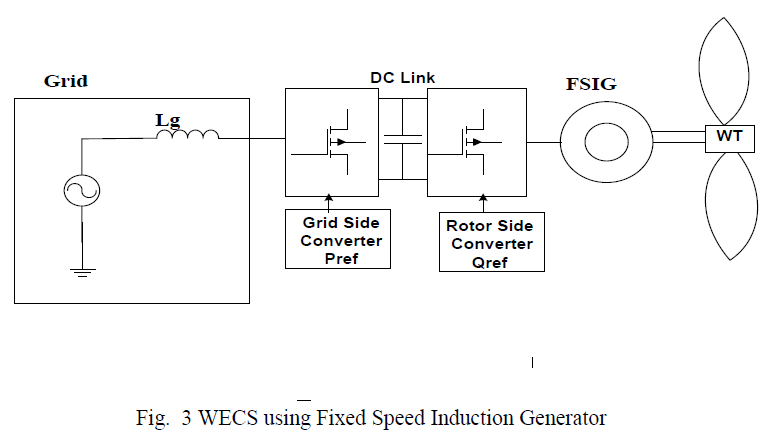 |
B. DOUBLY FED INDUCTION GENERATORS (DFIG) |
| The doubly fed induction generators (DFIG) are wound rotor induction generator. The DFIG is based on the concept, which corresponds to a variable speed wind turbine configuration with a wound rotor induction generator (WRIG) and a partial-scale power electronic converter on the rotor circuit, as illustrated in Fig. 4. The stator is directly connected to the grid, whereas the rotor is connected through a back to back power electronic converter. The power converter controls the rotor frequency and thus the rotor speed. This concept supports a wide speed range operation, depending on the size of the frequency converter. Typically, the variable speed range is +30% around the synchronous speed. The rating of the power electronic converter is only 25–30% of the generator capacity, which makes this concept attractive and popular from an economic point of view. |
| There are various advantages of DFIG reported as its controllability of both active and reactive power is better. The large rotor inertia smoothes the variations of wind speed and as a result it has fewer fluctuations in output power. The most important advantage of DFIG is its ability to get ride through fault by its uninterruptable operation. DFIGs connect to grid with selecting a good control; it has uninterruptable operation and can successfully ride through grid faults. The uninterruptable operation can be achieved by properly arranging the operation and control of the converters and using dynamic reactive compensation. |
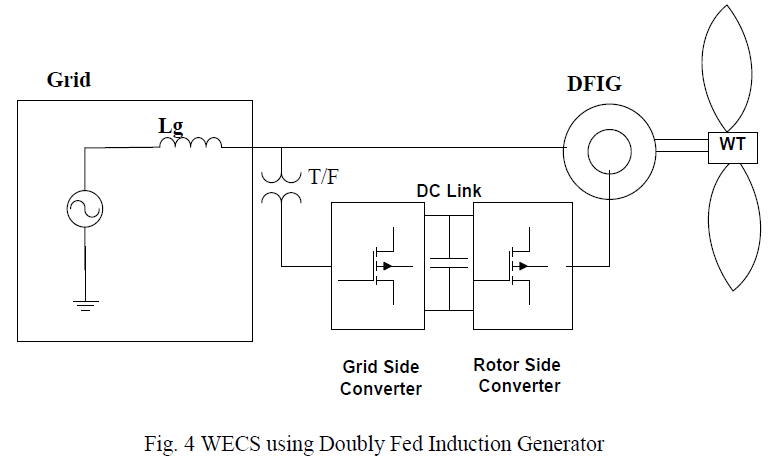 |
C. SYNCHRONOUS GENERATORS (SG) |
| Synchronous generators (SG) are considered one of the most-promising technologies for multi- mega watt (MW) windenergy conversion systems. The synchronous generators can be classified into the electrically excited synchronous generator (EESG) and the PMSG. Excitation is provided either with rotor windings or permanent magnets. Hence, fullscale power converters (FSCs) are needed, and a reduced scale converter for the excitation is required for synchronous machines without permanent magnets. Wind energy conversion system using synchronous generator with power control connected with power grid is shown in Fig. 5. |
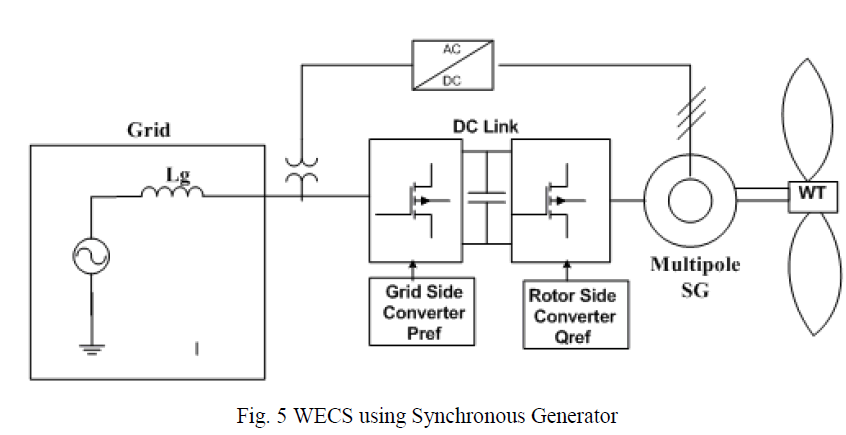 |
MPPT FOR ENERGY CAPTURE |
| The maximum power point of a wind turbine is the function of the wind speed. The purpose of the MPPT is to ensure that the maximum available energy from wind is extracted for a particular combination of wind turbine, generator and the power electronic converter of the WECS. To ensure the higher operational efficiency of wind energy conversion system using DFIG and power electronic converter the suitable maximum power point tracking (MPPT) technique is required to compensate for unknown or time-varying parameters, which are sometimes the cause of poor efficiency. The principle aim of MPPT controller is to maximize the generated output electric power and generator efficiency without the need for a low speed or high-speed shaft encoder, eliminating concern about sensor reliability. As Fig. 2 representing the power curve of a typical wind turbine, the operating condition for the optimum output can be obtained for various wind speed values. Intelligent control strategies for energy optimization include the data-mining methods, which also consider the power demand from the utility grid, as well as MPPT techniques. On the basis of literature survey the various possible MPPT techniques which are currently in practice are identified [16] - [21]. They are listed below- |
| Algorithms for searching optimum operating point. |
| Power system stabilizers (PSS) in DFIG system improves the damping of oscillations in the network. |
| Flux magnitude angle control (FMAC). |
| Hill climbing search (HCS). |
| Tip speed ratio (TSR) control. |
| Power Signal Feedback (PSF) control for dynamic stability control. |
| Optimal Torque (OT) control. |
| Mapping power technique in which maps/curves are used to find out the optimum point. |
| Anemometer method which uses the predetermined look up table. |
| MPPT by maximum efficiency control and a maximum torque control. |
| Advance hill climb search (AHCS) technique. |
| MPPT algorithm by directly adjusting the DC/DC converter duty cycle. |
| MPPT algorithms by changing the speed reference in the desired direction. |
| MPPT using two converters and by adjusting the switching frequencies of the two converters achieve maximum power tracking g and output voltage regulation. |
| Using matrix converter in DFIG. |
| Using MPPT algorithms with current feedback. |
| Sliding mode control using fuzzy for variable speed wind turbine. |
| Unity power factor and maximum power point tracking using loop control. |
| Maximum Power Point Tracking based on adaptive control strategy. |
| Adjustment of gear ratio with the change of wind speed to achieve the maximum power from the system. |
| Neural network techniques |
| The above mentioned MPPT techniques are also used to forecast the wind to achieve higher energy conversion efficiency to ensure the significant WECS contribution in power sector. The significant purpose of the MPPT is to ensure the tip speed ratio of the wind turbine as close as possible to optimal tip speed ratio. As the operation conditions are wind profile dependent therefore all the MPPT methods identified are not suitable for all kind of wind generators. Sliding mode control, P & O, adjustment of gear ratio, optimal torque control methods of MPPT are found to be suitable for small rating WECS. They have slow and sluggish response. MPPT techniques like HCS, AHCS, TSR, anemometer method, MPPT algorithms by changing the speed reference and mapping power technique in which the maps/curves are used to find out the optimum point of operation which works well in the smooth wind conditions only. They are complex and less reliable P&O, TSR, PSF, HCS and PSS MPPT techniques are widely employed in wind generators. As P & O does not require prior knowledge of maximum wind turbine power at different wind velocity and electric machine parameters. In TSR method the instantaneous tip speed ratio value is calculated on-line. PSF improves the dynamic stability control of WECS. HCS technique is most preferred in small capacity WECS for smooth wind speed. PSS technique improves the damping of oscillations in the network. |
| The suitable MPPT techniques enhance the net power capture. The basic and important advantage of the MPPT is to operate the WECS at variable wind profile with optimum output. This contributes significantly in the development and growth of WECS to increase its participation in the net global power generation. |
PROPOSED CONVERTER CONTROL |
| The proposed DFIG based WECS control scheme is presented in the Fig. 6. The wind turbine transmits mechanical power to the DFIG through a drive train according to nominal turbine speed, number of generator pole-pairs and network frequency. As per the wind profile the operating conditions of the WECS varies between the sub-synchronous to super synchronous range. The parameter recording unit measures the instantaneous value of rotor speed and the corresponding signals are fed to the control unit performing the maximum power point tracking operation. On the basis of the signals from the parameter recording unit and the MPPT control unit the corresponding signals are fed to the matrix converter unit as shown in Fig. 6. The slip value varies accordingly. The slip power flows from and to the rotor circuit through the Rotor Side Converter for the super and sub-synchronous operation modes of operations respectively. |
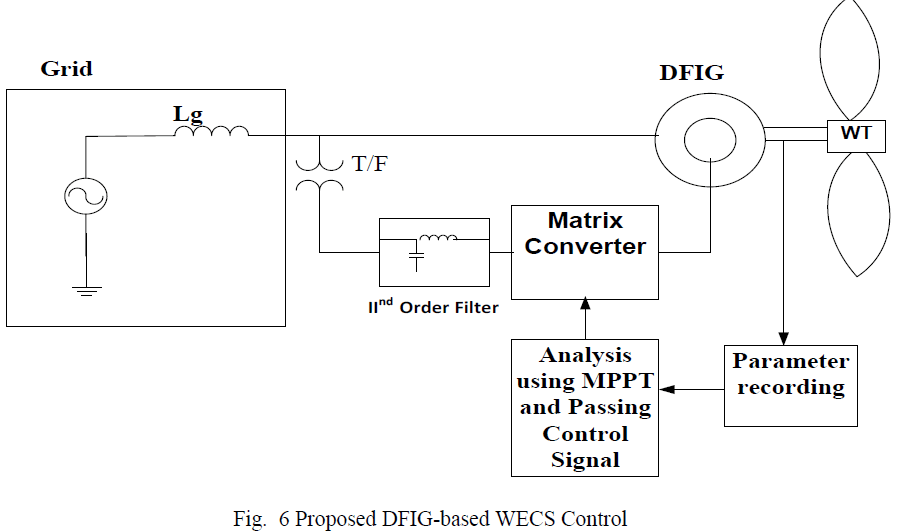 |
| The sub-synchronous and the super-synchronous modes of operation are investigated separately during optimization process. Hence as per the mode of operation the controlling strategy is implemented accordingly as mentioned in table1. |
 |
| Where α1 and α2 are the firing angles for converter1 (RSC) and converter2 (GSC). Under these constraints, the net output power from the DFIG is maximised for different values of the wind speeds and the corresponding firing angles of the converters are determined. |
 |
 |
| Table2 gives the summary of wind energy conversion system using DFIG for various generator-converters topologies. The cost of the overall system increases as the complexity of the power electronic converter increases. The intricacy of the controller design also affects cost; for example the use of MPPT techniques would cost more than a simple look-up table method. However higher order control and converter designs may increase efficiency of the overall system. The inclusion of a DC-boost stage helps reduce the control complexity of the grid inverter at a small increase in cost. Likewise, replacing the diode rectifier with a controlled rectifier allows for a wider range of control of both the generator and grid real and reactive power transfer. |
SIMULATION STUDY AND RESULTS |
| The proposed DFIG based WECS using matrix converter topology described above is simulated using MATLAB at variable wind velocities to operate the system at sub synchronous and super synchronous speed as shown in Fig. 7. The various parameters like stator current, rotor current, real power and reactive power were analysed. |
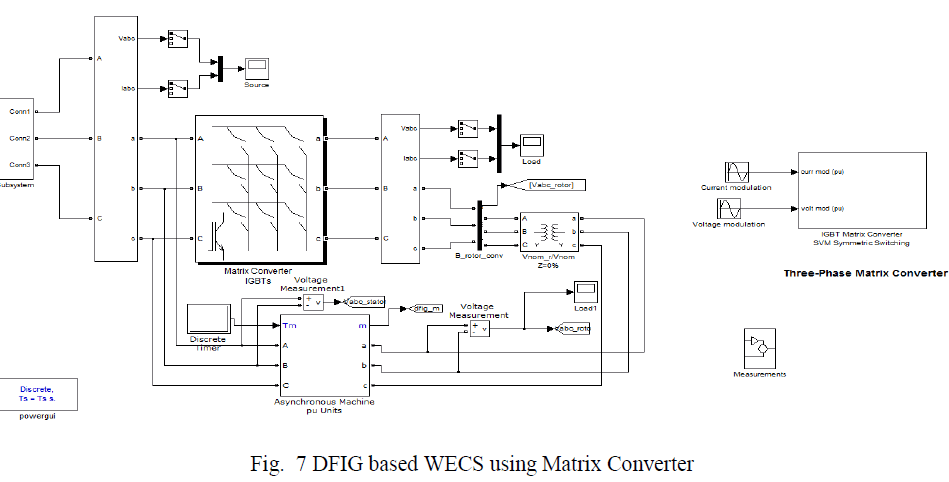 |
| Stator current is shown in Fig. 8 for phase âÃâ¬Ãâa‘. It is observed that the stability is achieved very soon to ensure the stable and efficient operation of the WECS. |
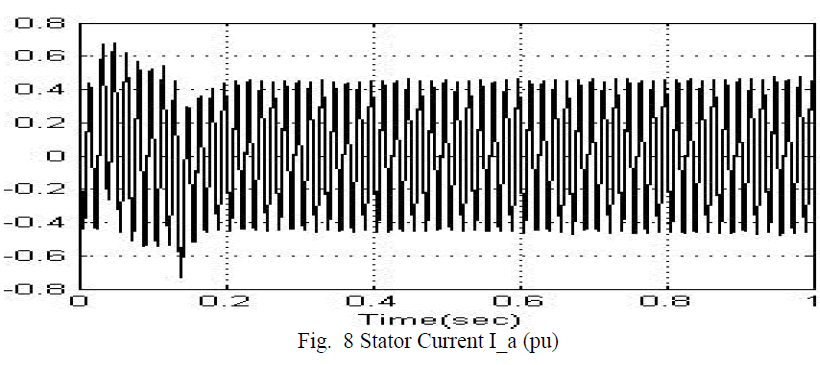 |
| Stator current for phase âÃâ¬Ãâb‘ is shown in Fig. 9. The result shows that it stabilises before 0.2 sec and the quality current is achieved. |
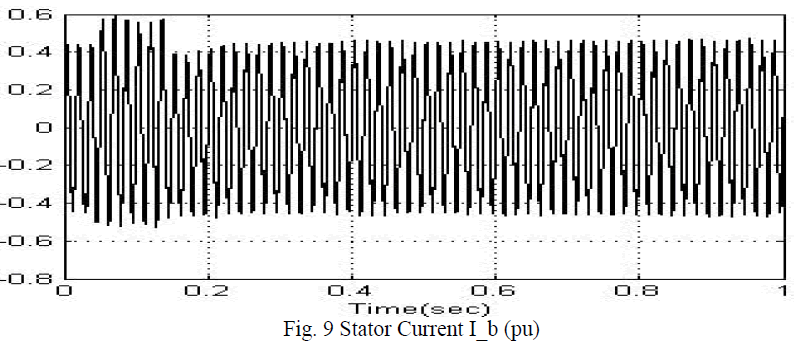 |
| Stator current for phase âÃâ¬Ãâc‘ the stator current is shown in Fig. 10. It is observed that the stable operation is achieved. |
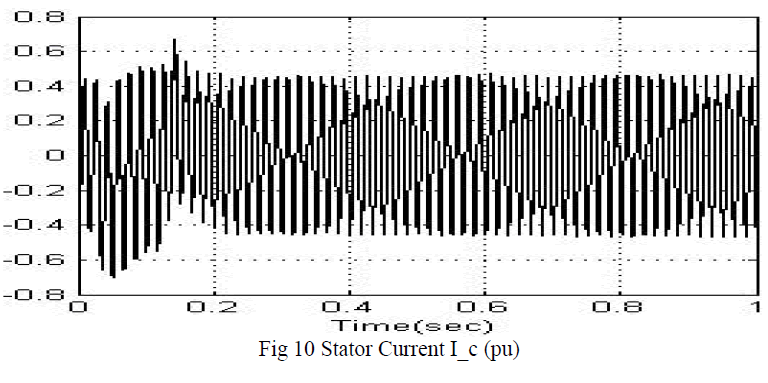 |
| The rotor current of phase âÃâ¬Ãâa‘ is shown in Fig. 11. The harmonic contents are observed to be minimised. |
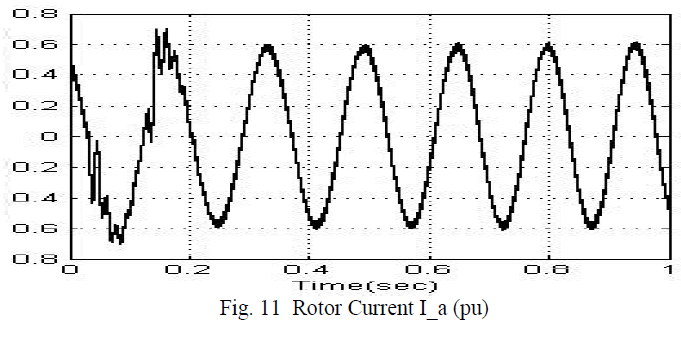 |
| The rotor current for the phase âÃâ¬Ãâb‘ it is shown in Fig.12 below. It is observed that the rotor current is stable. |
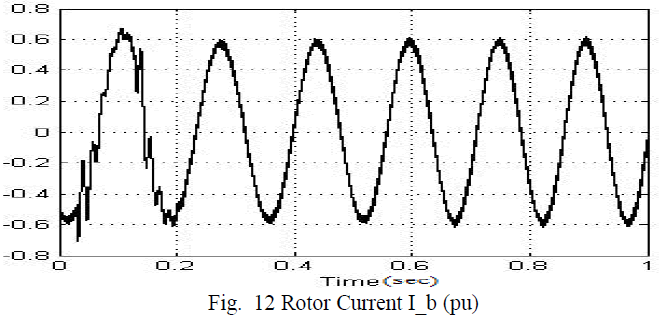 |
| Fig. 13 represents the rotor current for phase âÃâ¬Ãâc‘. The stable and quality power is obtained. |
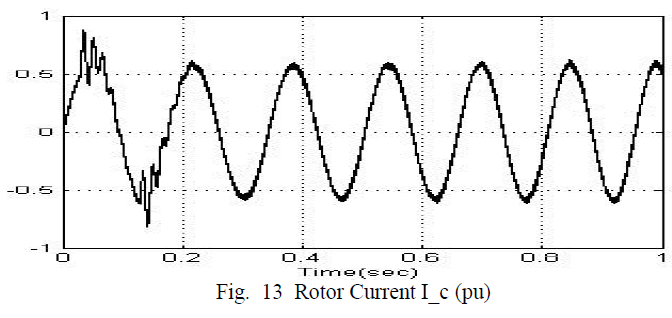 |
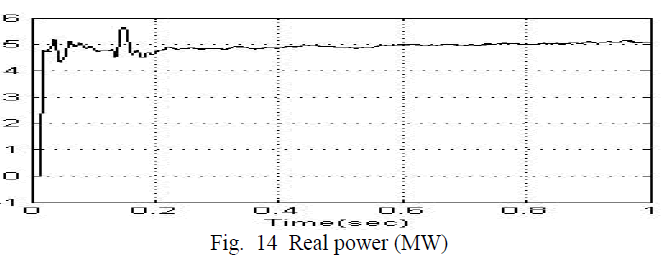 |
| The real power obtained from the proposed WECS is shown in Fig. 14. It is observed that the stable and quality power is generated at variable speed wind profile using matrix converter. |
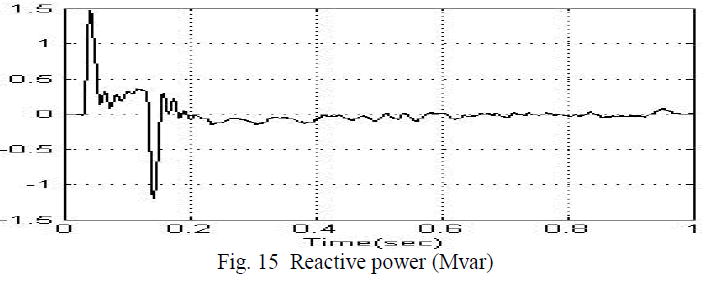 |
| The reactive power characteristic is shown in Fig. 15. From the results it is observed that the application of suitable filter with the matrix converter; the harmonic contents in the stator and rotor currents are mitigated this ensures the better power quality. The real power characteristic shows that it met the requirement which insures the grid integration of WECS. The reactive power characteristic ensures the smooth and satisfactory operation of WECS integrated with power grid. The use of DFIG with matrix converter in wind turbines is emerging rapidly and more and more research is being done in many areas of study relating to the use of such a system for extracting wind energy for electricity generation. |
CONCLUSION |
| It is concluded that the power-electronic technology plays a very important role in the integration of renewable energy sources into the power grid under variable wind scenario. The popularity of DFIG systems are due to its competitive advantages over other types of generators and hence are more widely being used in large power grids in order to add power to the grid. Smaller systems do not usually use DFIG systems due to the complexity involved in the use and control of power electronics involved. In the paper it is demonstrated that the suitable MPPT method for the wind energy conversion system including an MC ensures the maximum possible quality power generation at variable wind profile. The controller equipped with the MPPT algorithm controls to maximize the power captured from the wind turbine. This is possible by adjusting the MC control. The simulation results show that the performance of the grid connected WECS is better at variable wind profile using matrix converter. |
References |
|